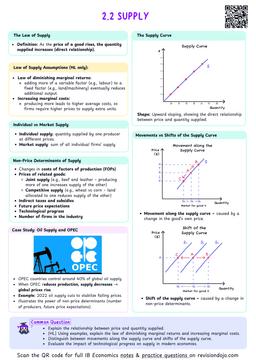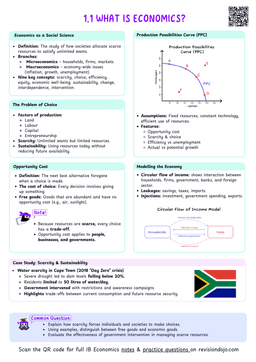Consumer surplus
The difference between the highest price consumers are willing and able to pay for a good or service and the actual price they end up paying.

Producer surplus
The difference between the price sellers receive and the lowest price that they are willing and able to accept.
The figure above (Figure 1), showcases both consumer surplus and producer surplus:
- The demand curve represents the maximum price consumers are willing to pay.
- The supply curve represents the minimum price that producers are willing to earn.
- The equilibrium price represents the actual price paid and earned by consumers and producers respectively.
- Therefore, the area between the demand curve and the equilibrium price is the consumer surplus (the difference between the price at which consumers are willing and able to pay for a good and what they are paying for it at the equilibrium price).
- Similarly, the area between the supply curve and the equilibrium price is the producer surplus (the difference between the minimum price at which producers are willing and able to produce the good and what they are receiving for it at the equilibrium price).
Hence, both producer and consumer surplus can be thought of as the benefit between the actual price and willing price.
Consumer surplus as consumer benefit
Consumer surplus shows that many consumers, while willing to pay a higher price, are able to buy the good (or service) for less at $P_e$ (Figure 2):

- Many people were willing to pay $P_1$ for quantity $Q_1$ yet they were able to buy a quantity of $Q_1$ for only $P_e$.
- The difference between $P_1$ and $P_e$ is the consumer surplus $(P_1-P_e)$ for quantity $Q_1$.
- Again for quantity $Q_2$, consumers were willing to pay $P_2$ but they received it for $P_e$ thus $P_2 - P_e$ is the consumer surplus for $Q_2$.
- This applies for all prices between the maximum price $P_{max}$ the consumer is willing to pay and the equilibrium $P_e$ represented by the upper triangle area.
The consumer surplus on a graph is the area
- Above the price the consumer pays
- Below the demand curve
- From 0 to the quantity actually purchased (equilibrium quantity).
Producer surplus as producer benefit
Similarly, producer surplus shows that many producers, while willing to receive a lower price, are able to sell the good (or service) for more at $P_e$ (Figure 3):

- Firms were willing to earn $P_3$ to sell quantity $Q_1$ yet they were able to sell a quantity of $Q_1$ for $P_e$.
- The difference between $P_3$ and $P_e$ is the producer surplus $(P_e-P_3)$ for quantity $Q_1$.
- Again for quantity $Q_2$, producers were willing to pay $P_4$ but they sold it for $P_e$ thus $P_e - P_4$ is the producer surplus for $Q_2$.
- This applies for all prices between the minimum price $P_{min}$ that the firm (or firms) is willing to receive and the equilibrium $P_e$ represented by the lower triangle.


